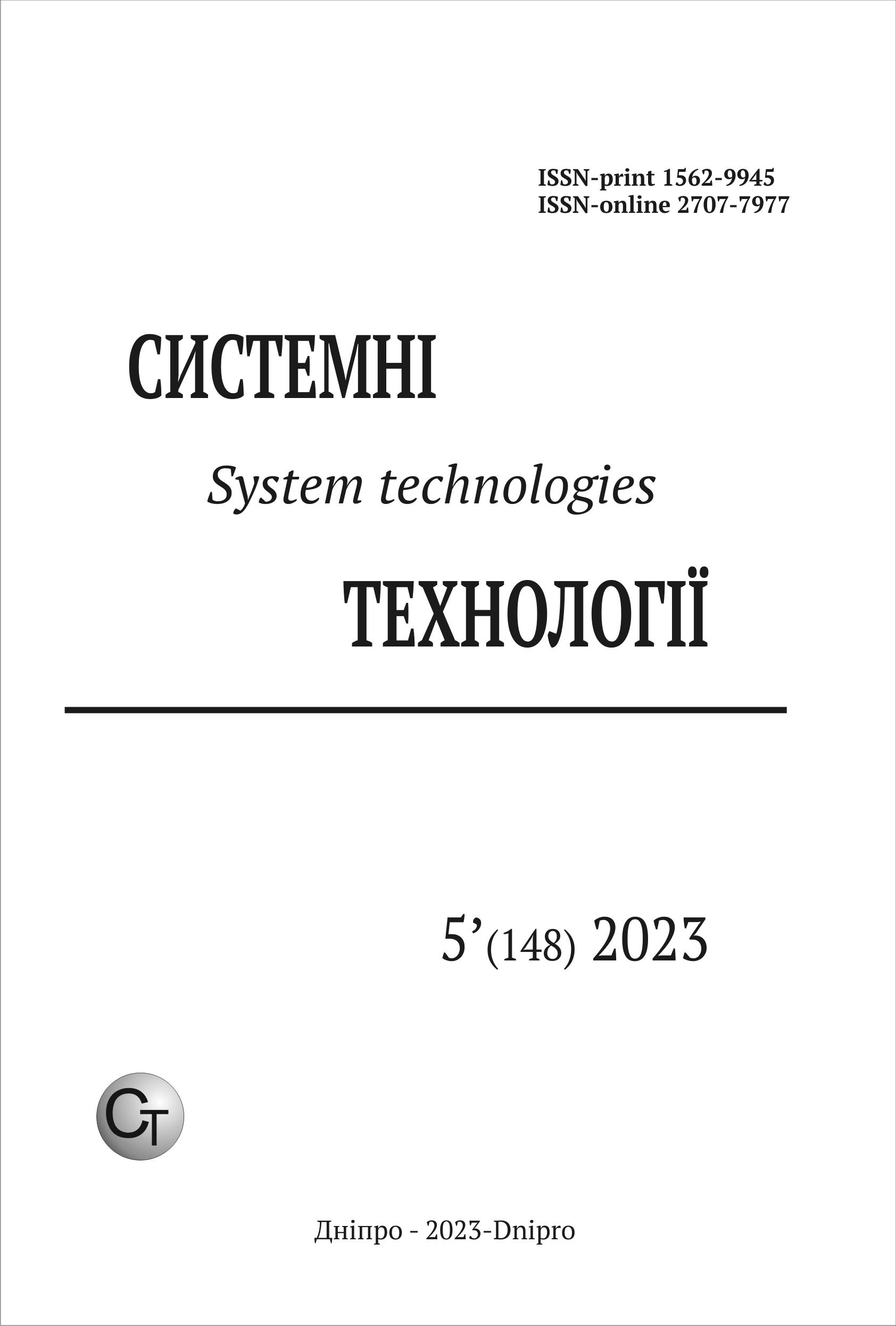КЛАСТЕРИЗАЦІЯ ТРАЄКТОРІЙ БРОУНІВСЬКОГО РУХУ ЗА ДОПОМОГОЮ МАШИННОГО НАВЧАННЯ
DOI:
https://doi.org/10.34185/1562-9945-5-148-2023-10Ключові слова:
Броунівський рух з дрейфом, рух частинок у пастках, кластеризація за допомогою машинного навчання, DBSCANАнотація
Стаття присвячена виявленню пасток, які захоплюють броунівську частинку, за допомогою машинного навчання. Проведено моделювання траєкторії броунівської частинки за допомогою моделі броунівського руху із дрейфом, що охоплює як вільну дифузію, так і рух у пастці. Для кластеризації часових даних використовуються метод кластеризації на основі щільності DBSCAN. Універсальність цього метода дозволяє ідентифікувати кластери без попереднього знання їхньої кількості або форми, що робить його придатним для виявлення пасток. Проведе дослідження показує, що застосування методу DBSCAN дозволяє досягнути середньої точності 95.0%.
Посилання
E. Frey and K. Kroy, "Brownian Motion: a Paradigm of Soft Matter and Biological Physics," Ann. d. Phys. (Leipzig), vol. 14, pp. 20-50, 2005. [Online]. Available: arXiv:cond-mat/0502602.
M.A. Pinsky and S. Karlin, Brownian Motion and Related Processes[Online]. Avail-able:https://faculty.ksu.edu.sa/sites/default/files/an_introd_to_stoch_modeling_4th_ed.pdf.
L. Kirichenko and R. Lavrynenko, "Probabilistic Machine Learning Methods for Fractional Brownian Motion Time Series Forecasting," Fractal and Fractional, vol. 7, no. 7, pp. 517, 2023. DOI:10.3390/fractalfract7070517.
C. Bustamante, J. Liphardt, and F. Ritort, "The nonequilibrium thermodynamics of small systems," Physics Today, 2005. [Online]. Available: https://arxiv.org/ftp/cond-mat/papers/0511/0511629.pdf.
L. P. Faucheux et al., "Optical thermal ratchets," Physical Review Letters, vol. 74, no. 8, pp. 1504-1507, 1995. DOI: 10.1103/PhysRevLett.74.1504.
V. Briane et al., "A computational approach for detecting micro-domains and con-finement domains in cells: A simulation study," Phys. Biol., vol. 17, p. 025002, 2020. DOI 10.1088/1478-3975/ab5e1d.
V. Briane, V. Kervrann, and M. Vimond, "Statistical analysis of particle trajectories in living cells," Phys. Rev. E, vol. 97, p. 062121, 2018. DOI:10.1103/PhysRevE.97.062121.
Y. Lanoiselée et al., "Detecting Transient Trapping from a Single Trajectory: A Structural Approach," Entropy, vol. 23, p. 1044, 2021. DOI:0.3390/e23081044.
P. Koo and J. K. Mochrie, "Systems-level approach to uncovering diffusive states and their transitions from single-particle trajectories," Phys. Rev. E, vol. 94, p. 052412, 2016. DOI:10.1103/PhysRevE.94.052412.
N. Meilhac et al., "Detection of confinement and jumps in single-molecule mem-brane trajectories," Phys. Rev. E, vol. 73, p. 011915, 2006. DOI:10.1103/PhysRevE.73.011915.
A. R. Vega et al., "Multistep Track Segmentation and Motion Classification for Transient Mobility Analysis," Biophys. J., vol. 114, pp. 1018–1025, 2018. DOI: 10.1016/j.bpj.2018.01.012.
P. Dosset et al., "Automatic detection of diffusion modes within biological mem-branes using back-propagation neural network," BMC Bioinform., vol. 17, p. 197, 2016. DOI:10.1186/s12859-016-1064-z.
S. Aghabozorgi, A. Shirkhorshidi, and T. J. Wah, "Time-series clustering. A Dec-ade Review," Information systems, vol. 53, pp. 16-38, 2015.
L. Kirichenko, O. Pichugina, and H. Zinchenko, "Clustering time series of complex dynamics by features," CEUR Workshop Proceedings, vol. 3132, pp. 83-93, 2022.
S. Khlamov et al., "Statistical modeling for the near-zero motion detection of ob-jects in series of images from the data stream," in 12th International Conference on Advanced Computer Information Technologies (ACIT 2022), 2022, pp. 1-4. DOI: 10.1109/ACIT54803.2022.9913151.
L. Kirichenko, T. Radivilova, and A. Tkachenko, "Comparative analysis of noisy time series clustering," CEUR Workshop Proceedings, vol. 2362, 2019.
A. Alqahtani et al., "Deep Time-Series Clustering: A Review," Electronics, vol. 10, no. 23, p. 3001, 2021. DOI:10.3390/electronics10233001.
R. J. G. B. Campello et al., "Density-Based Clustering Based on Hierarchical Density Estimates," in Advances in Knowledge Discovery and Data Mining, PAKDD 2013, 2013, pp. 305-316. DOI:10.1007/978-3-642-37456-2_14.
L. Kirichenko et al., "Forecasting weakly correlated time series in tasks of elec-tronic commerce," in Proceedings of the 12th International Scientific and Technical Conference on Computer Sciences and Information Technologies, CSIT 2017, 2017, vol. 1, pp. 309-312, doi: 10.1109/STC-CSIT.2017.8098793.
L. McInnes and J. Healy, "Accelerated Hierarchical Density Based Clustering," in 2017 IEEE International Conference on Data Mining Workshops (ICDMW), New Or-leans, LA, USA, 2017, pp. 33-42, doi: 10.1109/ICDMW.2017.12.
S. Kadloor, R. S. Adve, and A. W. Eckford, "Molecular communication using Brownian motion with drift," IEEE Transactions on NanoBioscience, vol. 11, no. 2, pp. 89–99, 2012. DOI:10.1109/tnb.2012.2190546.
S. Zhu and C. Ravishankar, "A scalable approach to approximating aggregate queries over intermittent streams," in Proceedings. 16th International Conference on Scientific and Statistical Database Management, 2004., Santorini, Greece, 2004, pp. 85-94, doi: 10.1109/SSDM.2004.1311196.
S. Louhichi, M. Gzara and H. Ben Abdallah, "A density based algorithm for dis-covering clusters with varied density," 2014 World Congress on Computer Applica-tions and Information Systems (WCCAIS), Hammamet, Tunisia, 2014, pp. 1-6,
doi: 10.1109/WCCAIS.
Завантаження
Опубліковано
Номер
Розділ
Ліцензія
Авторське право (c) 2024 Системні технології

Ця робота ліцензується відповідно до ліцензії Creative Commons Attribution 4.0 International License.















